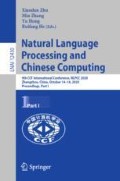Abstract
Causality mining, which aims to find cause-effect relations in text, is an important yet challenging problem in natural language understanding. The extraction of causal relations is beneficial to practitioners in document-intensive industries. For instance, it enables investors and regulators in financial industries to quickly understand the correlation between events in financial statements. However, this problem is difficult since the expression of causality is diverse, and more importantly, nested. Specifically, causality often has a nested structure, where a pair of cause-effect can be the cause of another higher-level causality. Recent works deal with this problem by a bottom-up relation extraction solution, but it performs worse for relations on higher levels. In this study, we find that the nested causality structure can be transformed into a graph of pairwise causality between sentence segments. Then we propose a two-step solution: first, a segmenter disassembles a sentence into segments by detecting causality connectives; second, a relation classifier predicts whether a pair of segments has cause-effect relation or not. Two modules above are trained jointly in our proposed Causality Detection Network (CDNet). On a large dataset we collect, the precision of our model reaches 92.11% and the recall reaches 93.07% for this task. Compared with the existing state-of-the-art solution, the precision of our model is improved by 3.28% and 3.03% for recall. We also observe that the percentage of exactly correct sentences from prediction is 74.26% without post-processing, indicating the hardness of our problem and space for improvement.
Access this chapter
Tax calculation will be finalised at checkout
Purchases are for personal use only
Notes
- 1.
Punctuation marks with higher pause level than commas such as semicolon or period also work here, while lower ones do not.
References
Cao, Y., Chen, D., Li, H., Luo, P.: Nested relation extraction with iterative neural network. In: CIKM, pp. 1001–1010. ACM (2019)
Duan, P., Yang, F., Chen, T., Shah, S.L.: Direct causality detection via the transfer entropy approach. TCST 21, 2052–2066 (2013)
Fu, J., Liu, Z., Liu, W., Zhou, W.: Event causal relation extraction based on cascaded conditional random fields. PR AI 24(4), 567–573 (2011)
Girju, R.: Automatic detection of causal relations for question answering. In: MultiSumQA, pp. 76–83 (2003)
Hobbs, J.R.: Toward a useful concept of causality for lexical semantics. J. Semantics 22(2), 181–209 (2005)
Ittoo, A., Bouma, G.: Extracting explicit and implicit causal relations from sparse, domain-specific texts. In: Muñoz, R., Montoyo, A., Métais, E. (eds.) NLDB 2011. LNCS, vol. 6716, pp. 52–63. Springer, Heidelberg (2011). https://doi.org/10.1007/978-3-642-22327-3_6
Kingma, D.P., Ba, J.: Adam: a method for stochastic optimization. In: ICLR (2015)
Li, Z., Li, Q., Zou, X., Ren, J.: Causality extraction based on self-attentive BiLSTM-CRF with transferred embeddings. ArXiv (2019)
Miwa, M., Bansal, M.: End-to-end relation extraction using LSTMs on sequences and tree structures. In: ACL, pp. 1105–1116 (2016)
Oh, J.H., Torisawa, K., Hashimoto, C., Sano, M., De Saeger, S., Ohtake, K.: Why-question answering using intra- and inter-sentential causal relations. In: ACL, pp. 1733–1743 (2013)
Pennington, J., Socher, R., Manning, C.: GloVe: global vectors for word representation. In: EMNLP, pp. 1532–1543. Association for Computational Linguistics (2014)
Surdeanu, M., Harabagiu, S., Williams, J., Aarseth, P.: Using predicate-argument structures for information extraction. In: ACL (2003)
Zhao, S., Liu, T., Zhao, S., Chen, Y., Nie, J.Y.: Event causality extraction based on connectives analysis. Neurocomputing 173, 1943–1950 (2016)
Zhao, S., et al.: Constructing and embedding abstract event causality networks from text snippets. In: WSDM, pp. 335–344 (2017)
Acknowledgments
The research work supported by the National Key Research and Development Program of China under Grant No. 2017YFB1002104, the National Natural Science Foundation of China under Grant No. U1811461.
Author information
Authors and Affiliations
Corresponding author
Editor information
Editors and Affiliations
Rights and permissions
Copyright information
© 2020 Springer Nature Switzerland AG
About this paper
Cite this paper
Chen, D., Cao, Y., Luo, P. (2020). Pairwise Causality Structure: Towards Nested Causality Mining on Financial Statements. In: Zhu, X., Zhang, M., Hong, Y., He, R. (eds) Natural Language Processing and Chinese Computing. NLPCC 2020. Lecture Notes in Computer Science(), vol 12430. Springer, Cham. https://doi.org/10.1007/978-3-030-60450-9_57
Download citation
DOI: https://doi.org/10.1007/978-3-030-60450-9_57
Published:
Publisher Name: Springer, Cham
Print ISBN: 978-3-030-60449-3
Online ISBN: 978-3-030-60450-9
eBook Packages: Computer ScienceComputer Science (R0)


